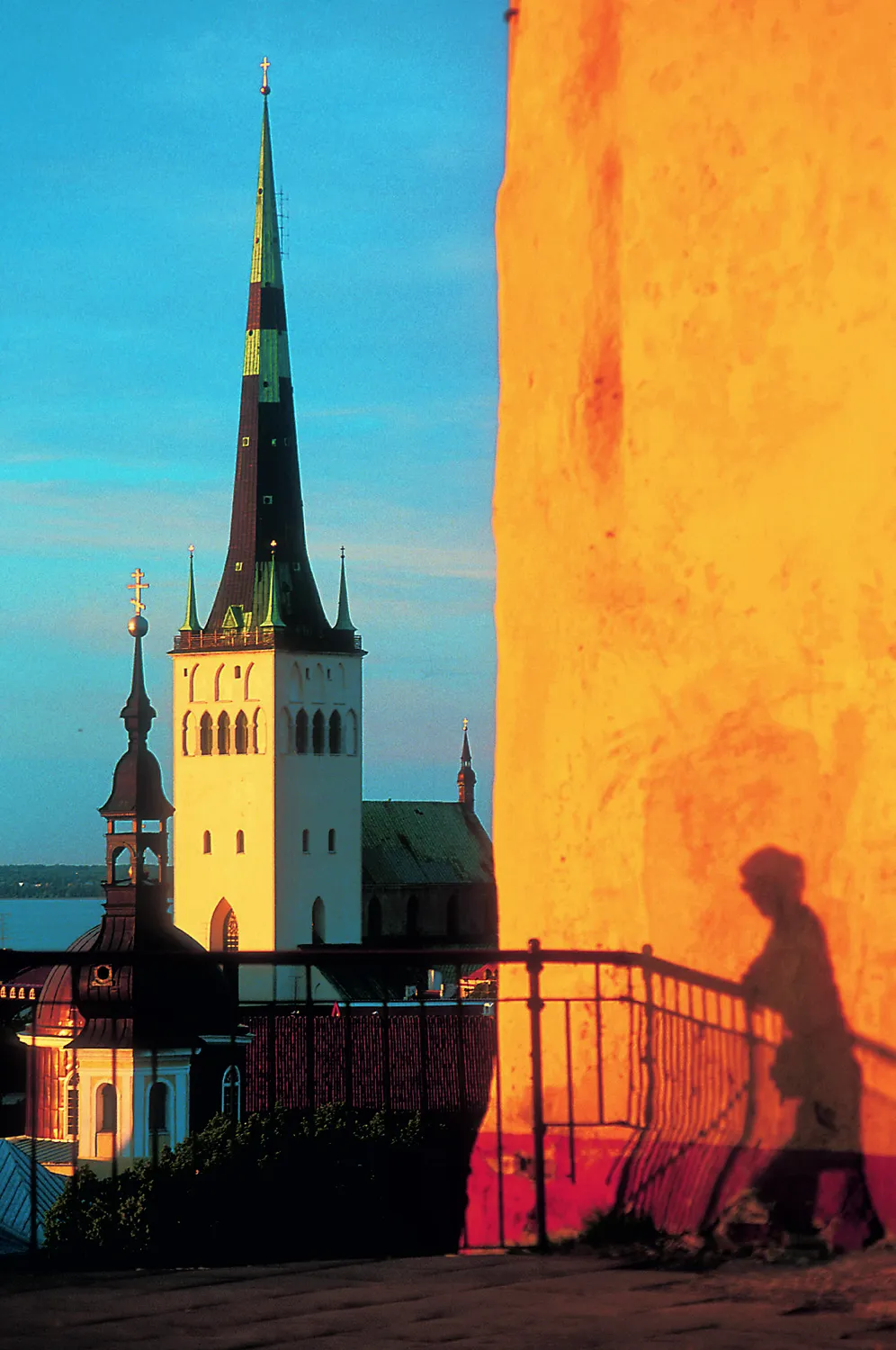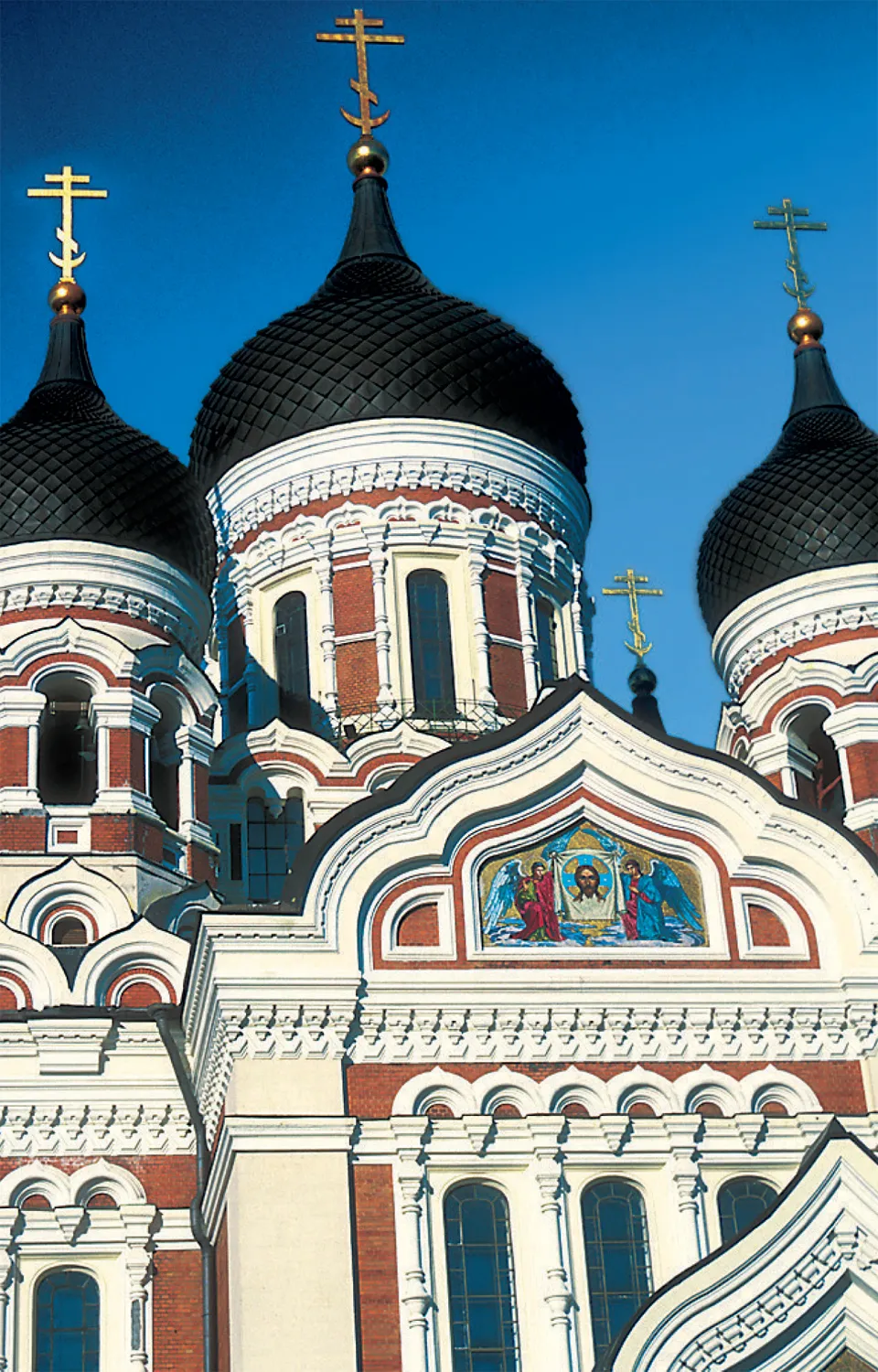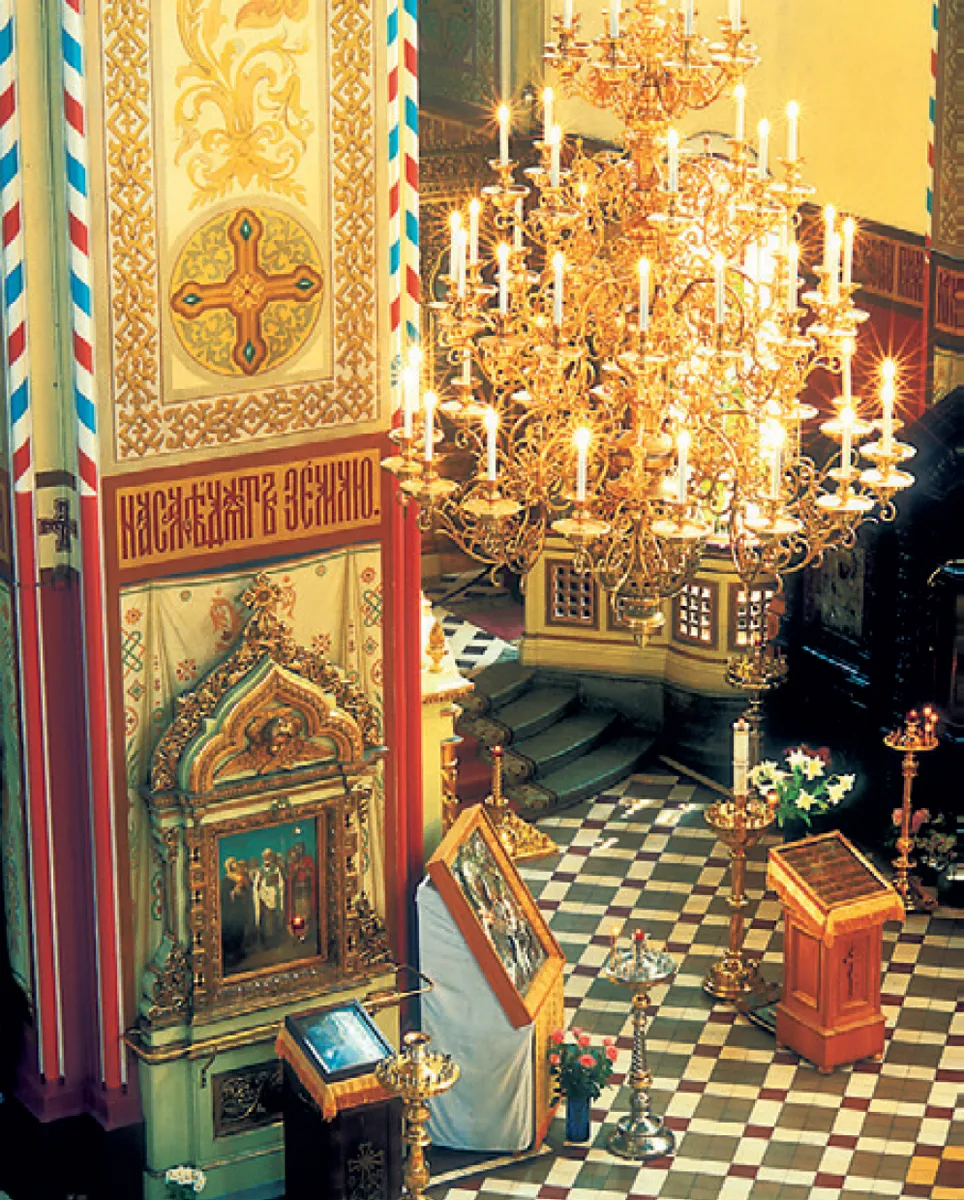When arriving in Tallinn, most visitors’ first instinct is to head straight into the Old Town – and rightly so. This tightly packed ensemble of winding, cobblestone streets, beautiful medieval dwellings, breathtaking church spires, café-filled squares and half-hidden courtyards isn’t just Tallinn’s biggest tourist draw, it is also the heart and soul of the city. Better still, it is all neatly packaged within a centuries-old town wall, giving it a fairy-tale charm and at the same time making it easy to navigate and explore.
View of St Olav’s Church from Toompea Hill
Anna Mockford and Nick Bonetti/Apa Publications
For a complete picture of the city, however, it is also essential to take a few steps beyond the medieval centre to see the wooden houses and offbeat attractions of Bohemian Kalamaja, the art and extravagance of Kadriorg and other surprising finds awaiting in the outlying areas.
Our tour starts at the birthplace of Tallinn – the Old Town. Today this district seems like one big, medieval mosaic, but it is actually made up of what were historically two distinct entities – Toompea Hill, home of the gentry and the representatives of Estonia’s ruling power, and the Lower Town, an autonomous Hanseatic trading city populated by merchants and craftsmen.
Toompea
Take one look down from the edge of this 24m (78ft) limestone hill and you will understand why Toompea has always been synonymous with power. Not only did its steep slopes provide a natural defence against would-be invaders, the high elevation gave it a commanding view of the comings and goings in the harbour nearby. It is no wonder then that ancient Estonians picked this spot to build a wooden stronghold, now thought to be the kernel of Tallinn. That fortress is long gone, but the tradition it started has continued. From the Danes in 1219 to the Russians in the early 20th century, every foreign empire that ruled the northern Estonian lands has used Toompea as its power base, stationing its political representatives in Toompea Castle.
Toompea Castle with the Pikk Hermann (Tall Hermann) Tower
Anna Mockford and Nick Bonetti/Apa Publications
The fortified area outside the castle, meanwhile, was home to Estonia’s gentry. German landlords, owners of feudal estates in the surrounding countryside, built grand, often palatial houses on Toompea from where they would look down, both literally and figuratively, on the busy merchants and workers in the Lower Town. Today most of these houses are embassies, government offices or high-priced flats.
Given Toompea’s history as the seat of the ruling power, it is somehow fitting that both Estonia’s Parliament and its government administration are now located here. What draws tourists to Toompea isn’t these grand institutions though, it is the prospect of seeing two of the nation’s most spectacular churches and getting the best views of Tallinn.
Pikk jalg is so steep that anyone driving a carriage down it was in for a harrowing experience, according to 19th-century accounts. Before the carriage started off, coachmen and tower guards had to shout to each other to ensure that the area at the bottom was clear of traffic.
Pikk Jalg and Lühike Jalg
Four roads and four stairways lead up to Toompea, but by far the most interesting paths up the hill are Tallinn’s two ‘legs’ – Pikk jalg (‘Long Leg’ Street) and Lühike jalg (‘Short Leg’ Street).
In medieval times, if you were travelling by horse or carriage, you would have taken Pikk jalg to reach Toompea from the Lower Town. It starts at the end of Pikk Street at the curious-looking Long Leg Gate Tower 1 [map] (Pika jala väravatorn) and continues in a straight, steady climb upwards to Castle Square (Lossi plats). The four-sided gate tower was built in 1380, but its present shape comes from a mid-15th-century reconstruction. Pikk jalg itself is a favourite haunt of local artists vying to sell their works to passing tourists. High above the artists’ heads, the extravagant mansions along the edge of the cliff serve as a good indication of the wealth and power of Toompea’s gentry.
Picturesque Lühike jalg was historically the main pedestrian passage into Toompea. Though officially a street, this is really just a narrow, winding lane with a staircase. Today it is flanked on both sides by some of Tallinn’s more intriguing art shops, and is also home to the Adamson-Eric Museum (www.ekm.ee; Wed–Sun 11am–6pm; charge), which showcases works of Adamson Eric (1902–68), one of the most outstanding Estonian painters and applied artists of the 20th century.
Aleksander Nevsky Cathedral
Anna Mockford and Nick Bonetti/Apa Publications
At the top of the street’s 16m (52ft) climb stands the Short Leg Gate Tower 2 [map] (Lühikese jala väravatorn), built in 1456. The tower was extensively renovated in the late 1980s, but the sturdy, wooden door you pass here is original and dates from the 17th century.
Orthodox Cathedral
When you reach Castle Square at the top of Toompea, you come to a dramatic, onion-domed church that looks like something straight out of a Russian novel. This is the Aleksander Nevsky Cathedral 3 [map] (Sun–Fri 8am–7pm, Sat 8am–8pm), the most impressive-looking Orthodox church in Estonia and an important place of worship for Tallinn’s Orthodox faithful. Built from 1894 to 1900, the cathedral is a relatively new addition to Toompea. It was designed by St Petersburg architect Mikhail Preobrazhensky and follows the same basic layout as the five-domed churches that started to appear in Moscow and Jaroslavl in the 17th century.
Though the cathedral serves a purely spiritual purpose these days, it was originally placed here as a blatant symbol of Russian power. In the late 19th century, imperial Russia was carrying out an intense campaign of Russification in its outer provinces. As part of its drive to assert cultural dominance over the mainly Lutheran Germans and Estonians, the tsarist government built this towering Orthodox cathedral directly in front of the castle, right on what had been one of the city’s most famous squares.
A chance to look at the cathedral’s interior shouldn’t be passed up. Visitors are welcome to come in and view the abundance of awe-inspiring icons, mosaics and other works of religious art that line the walls. The cathedral also operates a small gift shop to the right of the entrance.
Toompea Castle
Next to the cathedral stands a large pink edifice that bears a distinctly regal look. This is the front of Toompea Castle 4 [map] (Toompea Loss), historic seat of power in Estonia and home to the Riigikogu, Estonia’s parliament. The castle’s origins go back to 1227–9, when the Knights of the Sword replaced the wooden stronghold that pagan Estonians had used to defend the hill with their own square fortress, which they surrounded with a circular, stone wall. In the 14th century this was rebuilt into a convent-style fortress with a trapezoidal inner courtyard, 20m (65ft) high walls, and four corner towers, three of which are still standing. The baroque palace you see in front of you was built from 1767 to 73 on the order of Russian Empress Catherine the Great, and served as the administration building for the Russian provincial government in Estonia during tsarist times. The three-storey Parliament Building in the courtyard, not visible from the outside, was built in 1920–2 on the foundations of the former convent and reflects an Expressionist style.
Cathedral interior
Anna Mockford and Nick Bonetti/Apa Publications
Tourists aren’t allowed in the castle itself, but anyone can visit the peaceful Governor’s Garden to the left of the castle. This is the best place to view another Tallinn landmark, Tall Hermann (Pikk Hermann) tower. The tower was built onto the corner of the castle in 1371, but only reached its final 4...




